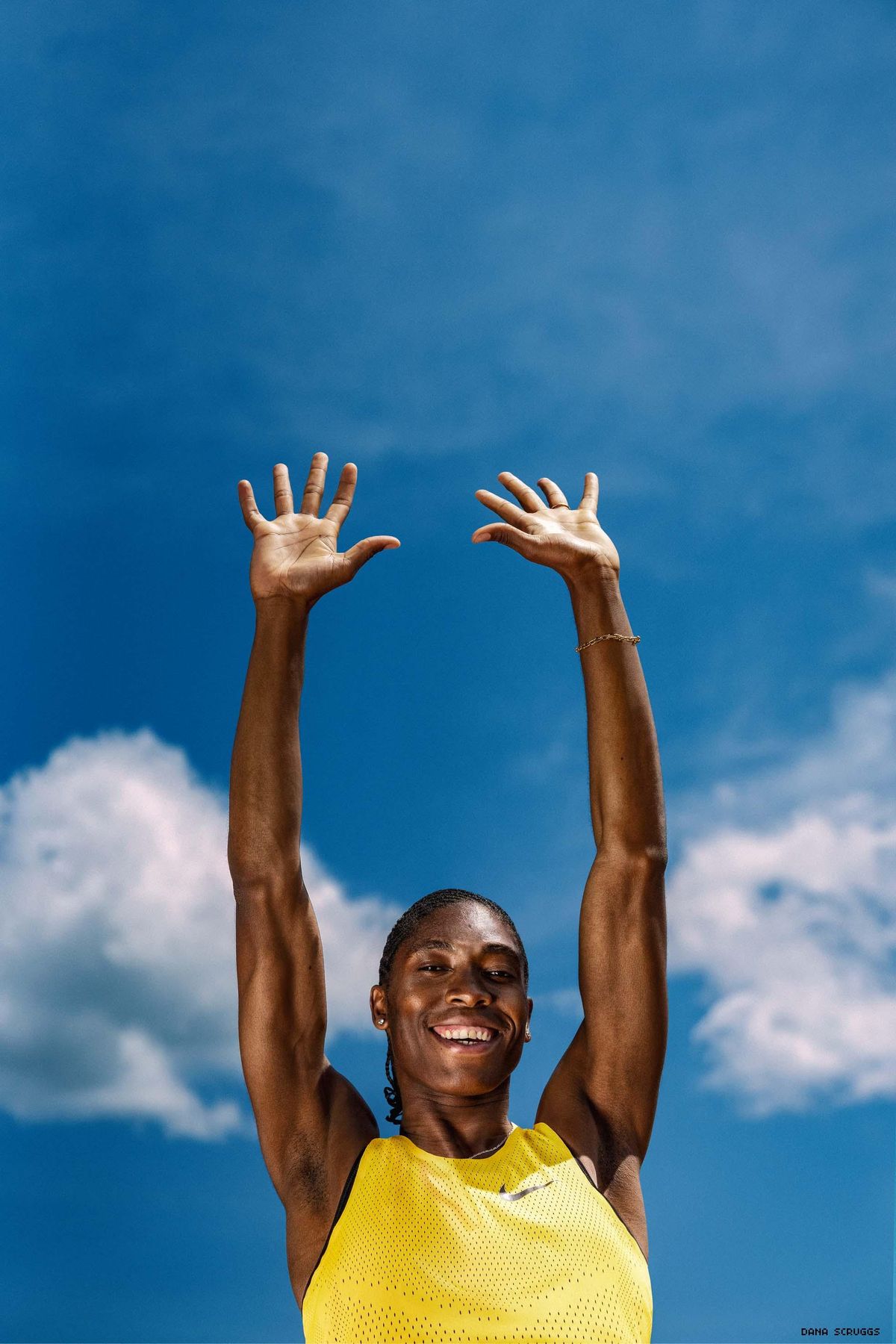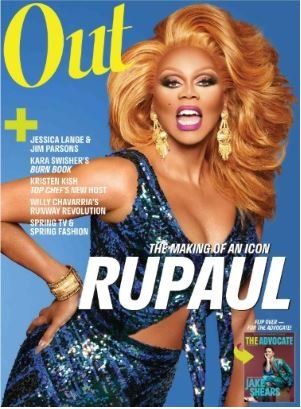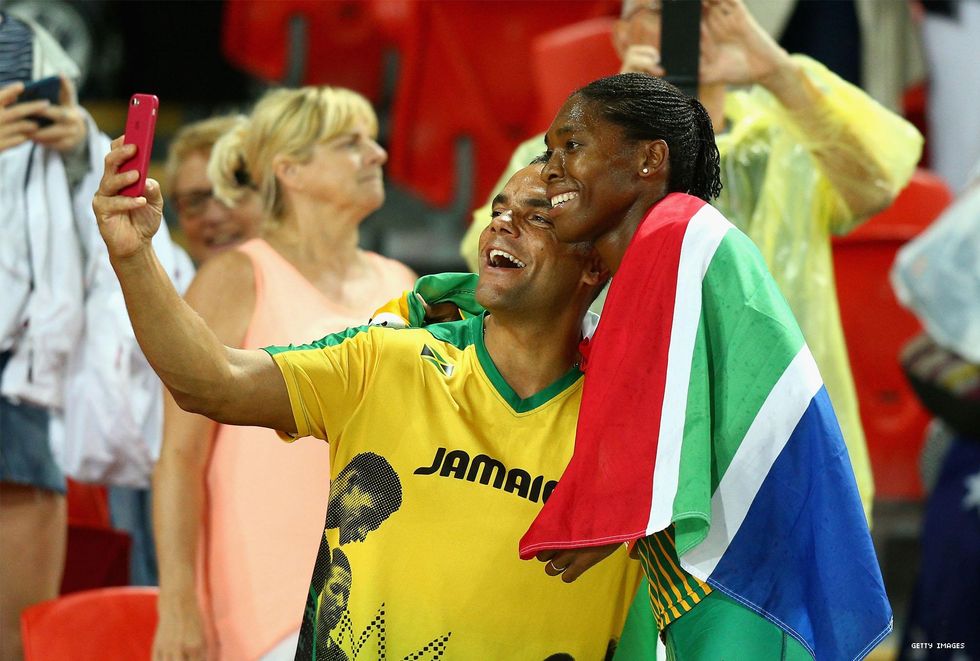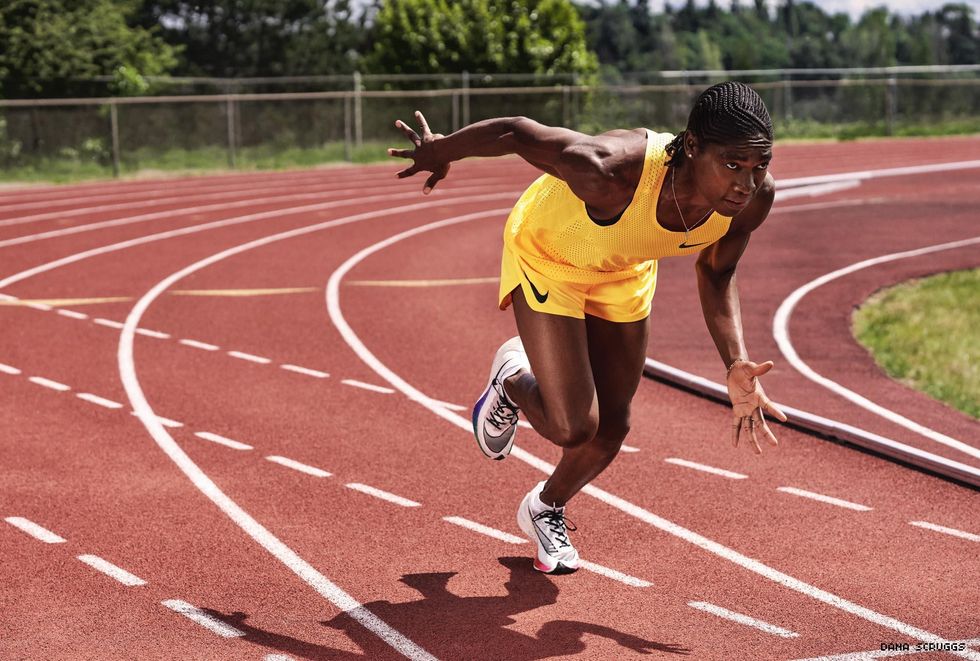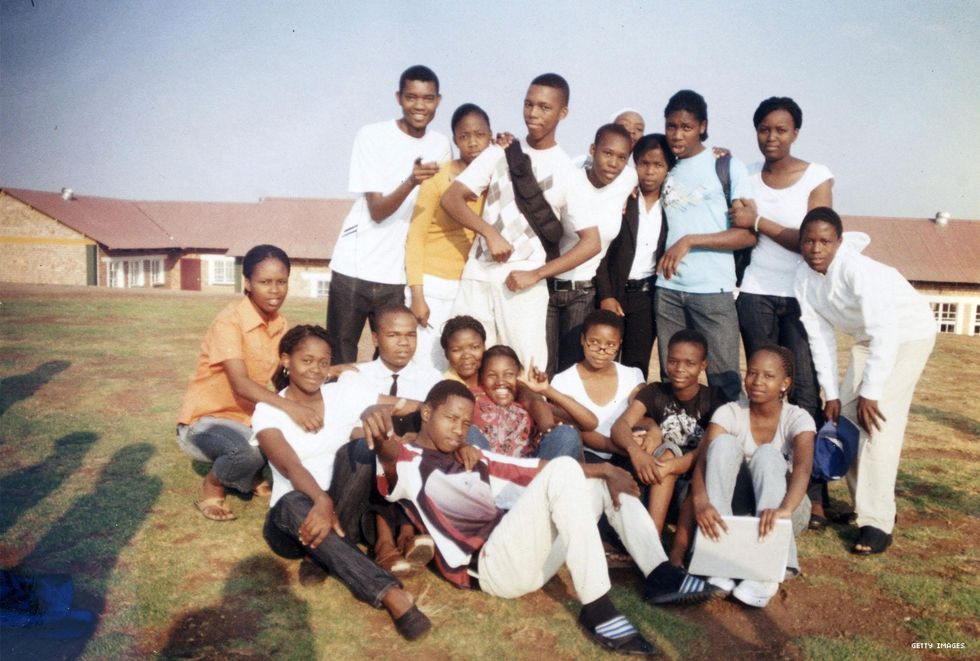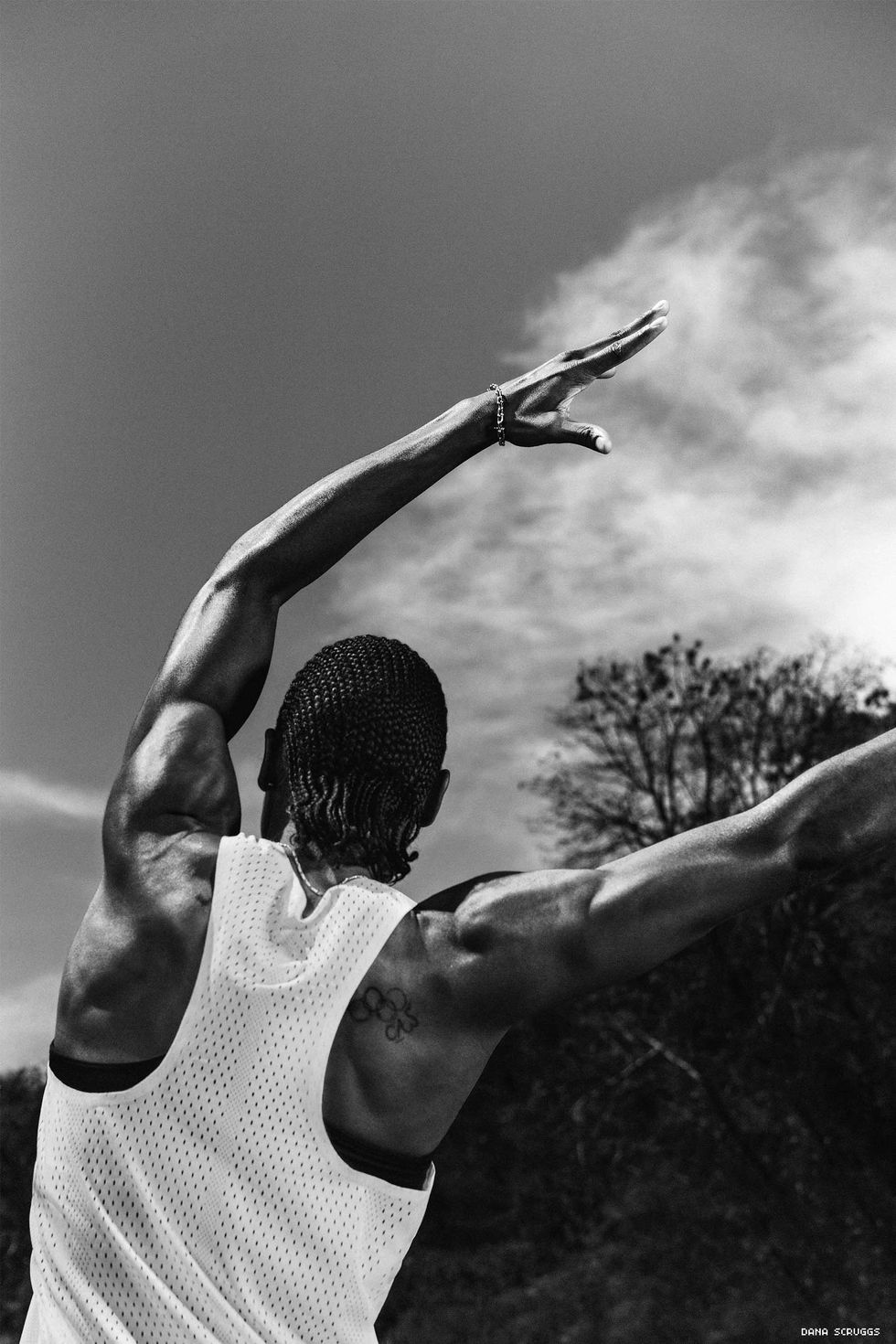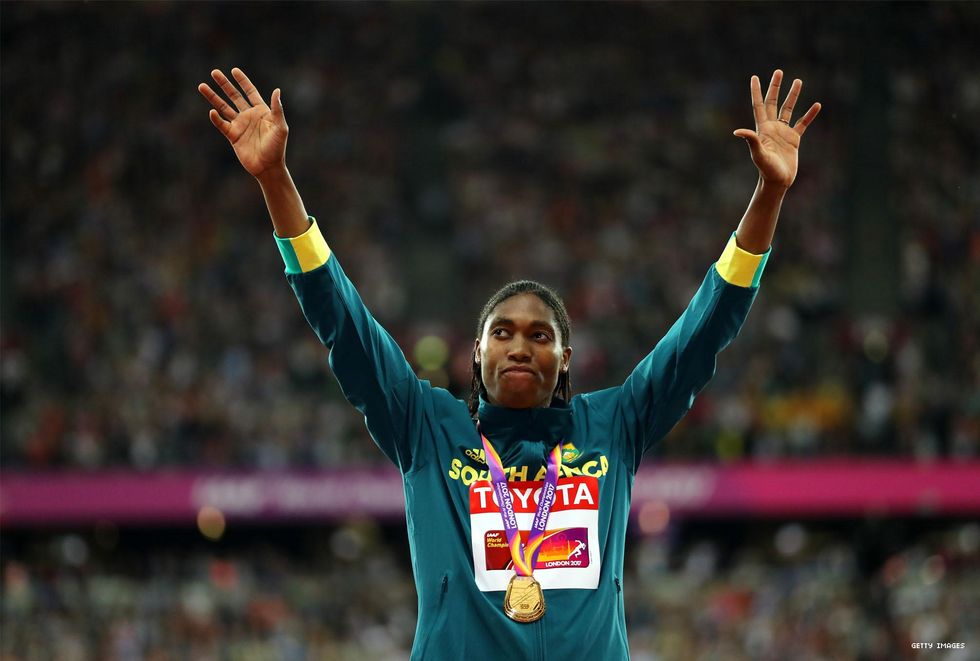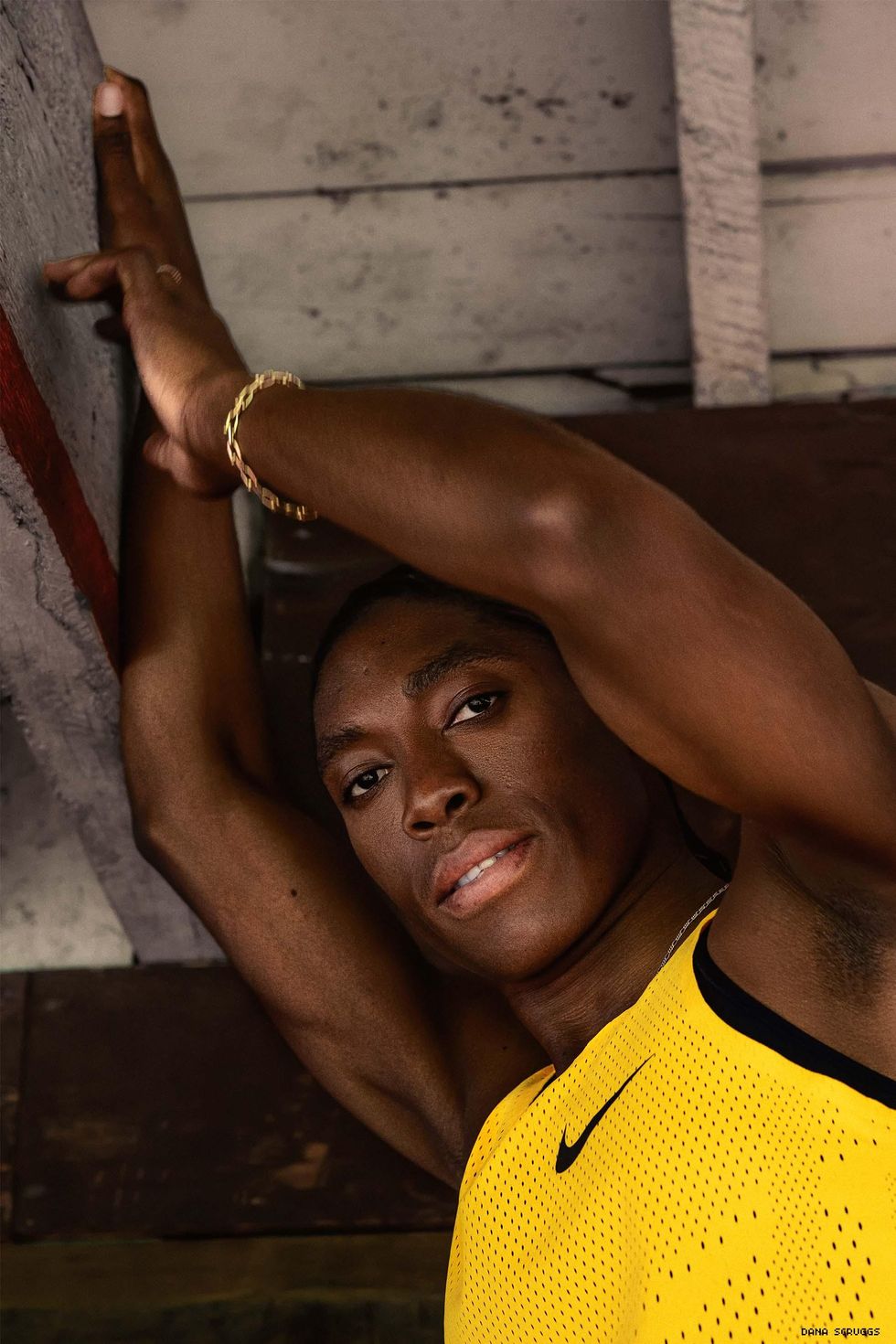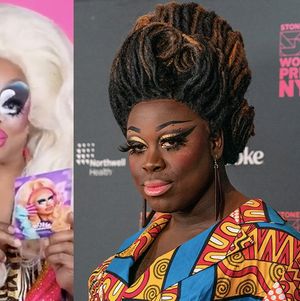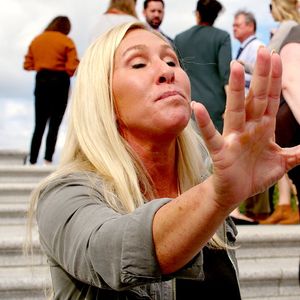Caster Semenya raises a fist as her name is announced over the loudspeaker: The South African runner stands in lane eight on a track in Doha, Qatar, at a Diamond League competition held this past May. She looks pissed.
As per usual, the crowd in the stands cheers loudly for her, remarkably more than almost all the other women in the surrounding lanes. As the runners take their marks, Semenya focuses on the starting line before her. When the race starts, she and Benin's Noelie Yarigo take off, their strides in sync with each other as they cut across the outside lanes to form a pack with the other runners. Yarigo's ponytail flaps against her shoulders as she holds on to her lead with Semenya. Yarigo pulls ahead, her stride long and steady. At first, it's shocking -- could she really break Semenya's winning streak? -- until Yarigo looks over her left shoulder to see Semenya right on her heels. As the women hit the midpoint of the race, Yarigo's stride changes, her body working overtime to keep a narrowed lead. Soon, she eases back and veers off the track, clearing the way for Semenya to take over. With the lead, Semenya doesn't pull back -- but instead digs in. With each step Semenya takes, Francine Niyonsaba of Burundi falls farther and farther behind. Semenya could ease up and still win. She doesn't. She kicks into high gear, besting Niyonsaba by nearly 20 meters when she crosses the finish line.
Once the race is over, Semenya takes her congratulatory flower bouquet and launches it into the crowd. She breathes hard, but it appears she's not even winded. The crowd is just as electrified as she is, shouting and cheering at her. The other women, her competitors, are slumped over or lying on the ground at the finish line.

Semenya poses with a fan in Australia.
The crowd goes wild, as it normally does now for Semenya, but not just for the typical reasons. The right reasons would be: Semenya won, and her athletic ability is practically a miracle to witness. Instead, this decisive win came with a dark cloud. At the time, it appeared this would be the last 800-meter race Semenya would ever run under the International Association of Athletics Federation (IAAF), which is track and field's global governing body. The organization, just two days prior, announced it would force her to reduce the levels of testosterone naturally produced in her body if she wanted to continue running her best event.
Caster Semenya, arguably one of the greatest runners in the world, was being effectively banned from competing.
Greater Than the Greats
Running through fields, kicking a ball between friends for hours, and playing pickup baseball games until the sun goes down, day in and day out -- this was the freedom of a rural childhood for Mokgadi Caster Semenya. Being a girl in Fairlie, a remote village in Limpopo, South Africa meant a life of chores, like fetching water and cleaning the house. But games with the local boys were her retreat from housework; her escape from being taunted for her tomboyish ways was running as far as her legs could take her.
"When I do sports is when I feel happy. I feel free," she says to Out on the set of our photo shoot on a Saturday afternoon in Seattle. "As long as I remember, it was all about being free." It turned out that freedom provided fertile ground for an incredible track and field talent to flourish. As a young teen, a local coach noticed her raw talent, and pulled her aside to tell her many of the greatest athletes in the world were African -- he added, "I think you can be better than any of them."
Semenya found track and field's middle distances -- a unique combination of sprint speed and marathon stamina -- as a teenager, mainly out of circumstance. Her remote village didn't have the resources that city kids had to learn the technical skills required of top-tier sprinters. "So I just decided, OK, in middle distance I can just run anywhere I want. I can run from one village to another. I can just run without any supervision." And so, she did exactly that.

With a sponsorship by Nike, Semenya is poised for success. Top, Shorts, and sneakers by Nike. Bracelet by Tiffany & Co. All other jewelry Semenya's own.
A Double-Sided Debut--and the Beginning of International Scrutiny
In Summer 2008, at 17, Semenya won the 800-meter race at the Commonwealth Youth Games with 2:04:23; an excellent time for the top tier of youth runners on the national and international circuit, but not headline-grabbing for an adult competing at that level. Then around her 18th birthday in January 2009, Semenya joined the University of Pretoria's athletic club, putting her talent through the wringer of consistent training.
By August 2009, she shaved seconds off her personal best in the 800-meter, and landed in lane four at the 800-meter final at the IAAF World Championships in Berlin. The gun went off, and the women scrambled into position. At 200 meters, Semenya glided near the front of the pack and halfway through, she took the lead. Semenya widened her gap every few meters, with her long, commanding stride. She looked powerful as she ran, as though nothing could come between her and the finish line, and yet the looseness in her face and her body portrayed an incredible -- enviable -- level of ease. As she rounded the final curve, she peeked over her shoulder. The pack was well behind her. She pulled ahead even farther on the last straightaway, keeping her long stride as the women behind her grasped for second and third place. The crowd was stunned, erupting as she crossed the finish line with nearly two and a half seconds between her and Janeth Busienei of Kenya. The tomboy who once ran from rural village to village had just completely disrupted the prim dealings of elite track and field, nabbing the fastest 800-time recorded in all of 2009.
The 800-meter barely qualifies as a distance race, but it is certainly not a sprint. Semenya, though, is built like a sprinter -- lean and agile, while muscular enough to run explosively fast -- but excels at building up from simply swift to full-tilt and staying there longer than her lankier competitors built to run longer distances. Think of it this way: Run almost as fast as your body possibly can for about a half-mile, and then run at your absolute maximum capacity for two more city blocks. That's what she does on the track. Semenya consistently dominates one of the trickiest races in track by widening her lead in the last quarter; when everyone is exhausted and trying to sustain their pace, she kicks in that last bit of energy to clinch a decisive win. The consistent strategy pays off; Semenya has been on a winning streak since 2015. It's also the reason she's been the target of scrutiny and insults throughout her elite track career.

Semenya among classmates in high school in Ga-Masehlong, South Africa. (Photo by Per-Anders Pettersson/Getty Images).
The World Versus Caster Semenya
Immediately after that mind-blowing 800-meter final at the 2009 World Championships, some of Semenya's fellow competitors went for the jugular. Italy's Elisa Cusma Piccione (sixth place) insisted she was a man. Russia's Mariya Savinova (fifth place) urged journalists to "just look at her." Other athletes whispered, stared, and laughed at her. Then came the IAAF.
Initially, the questions about her drastic improvement were linked to suspicions of doping. When those tests came back negative, she was subjected to rounds of gender testing, reportedly involving analysis by an endocrinologist, a psychologist, a gender expert, an internist; most humiliating was a gynecological exam that included photographing her genitals while her feet were in stirrups. Eventually she was cleared to compete on the international circuit again but not before she missed nearly a year of competition during the IAAF's deliberation over her test results.
The dirty secret here is that gender testing is common for women athletes -- and yes, only women athletes. Mandatory sex testing of women athletes was enforced by the International Olympic Committee in 1968, through a cheek swab. Before that, it was a gynecological exam. The fear was that men might enter women's races, just to win. (The joke would be on them, though -- winning in women's sports rarely ever means notoriety and riches.) Years of this type of invasive testing led to enough disgruntled women athletes unwilling to continue to submit to these procedures. Finally in 1992, the International Olympic Committee decided to drop mandatory testing but kept it as an option, just in case.
For Semenya, the inquiry was incredibly public. Through the eyes of many Black South Africans, this kind of testing is reminiscent of the colonial objectification of Black women's bodies. After all, Semenya was born during apartheid, during which racist tests were used to determine race -- and therefore justify discrimination -- against Black people. For instance, as an attempt to resolve racial ambiguity, one test involved placing a pencil in a Black person's hair to see if it slipped out (white!) or stayed in (Black!). More disturbingly, some invasive apartheid-era racial tests involved inspecting the skin color around a person's genitals. It's no wonder news of Semenya's genital inspection conjured horrifying reminders of this history.
Semenya returned to track in 2010, but after a year without competing, downgraded training, and then an injury, she entered a sort of dark period. Nonetheless, she weathered the bullshit, with her country pushing her along. In 2012, she qualified for the Olympics and carried the South African flag into the Olympic stadium during the opening ceremony's parade of nations before nearly 1 billion viewers around the world. During that Olympic Games, she won silver with a time of 1:57:23 against Russia's Savinova's 1:56:19. Ironically, it turned out Savinova, who complained about Semenya in 2009, was later disqualified for doping, turning Semenya's silver medal into a gold one.
Meanwhile, the IAAF established rules to restrict women runners from competing if they had naturally high levels of testosterone (or hyperandrogenism) in 2011. At the 2012 Olympics, four women from rural areas of developing nations between the ages of 18 and 21 were identified for carrying these traits -- and barred from competition. In 2014, Indian sprinter Dutee Chand challenged the IAAF's policies in the Court of Arbitration for Sport (CAS) after she was barred. The court ruled in 2015 that Chand had the right to compete, and that the IAAF's findings were inefficient in concluding that "hyperandrogenic female athletes may benefit from such a significant performance advantage" and therefore needlessly excluded them competing in the female category.
As the years went on, Semenya continued to win, and in 2015, she began a winning streak in 800-meter races that continues today. She even broadened her events to include the 400-meter and 1500 meters, racking up strong performances. But in 2018, after leaving plenty of disgruntled co-competitors in the dust -- and some in tears -- the IAAF created a new policy: To compete, women athletes would have to sustain a testosterone level of 5 nmol/L or less, either naturally, or through hormone therapy. Adding insult to injury, the rule would only be enforced for the 400-meter, 800-meter, and 1500-meter women's races. Semenya was the clear target.
She'd also had enough. "It is not fair that I am told I must change," she said at the time. "It is not fair that people question who I am. I am Mokgadi Caster Semenya. I am a woman, and I am fast." Soon after, like Chand before her, Semenya launched a legal battle against the IAAF. "I don't want to speak for her, but much of what we've seen in the media has really been that Caster has been thrust into this position and forced to take a stand," says Sarah Axelson, the director of advocacy for the Women's Sports Foundation. "Thank goodness she did."

Semenya carried the Olympic flag for South Africa during the 2012 Olympics opening ceremony. "Representing your country is everything," she says.
The Culture of Controversy
Based on the way the IAAF has continued to dismiss data from its own fact-finding, a policy based on uncontested science may still be a long way off. Katrina Karkazis, a Yale University researcher and co-author of the upcoming book Testosterone: An Unauthorized Biography, says the relationship between testosterone and gender has long been vastly misunderstood. If anything, hormones like testosterone and estrogen have been oversimplified to determine what makes a man and what makes a woman, especially in sports.
Yes, testosterone is the hormone generally identified with maleness. But it's also present in cisgender women. Testosterone is necessary for liver function, bone development, and plenty of other processes in the body. It's produced by the ovaries. "Men and women have it, men and women need it, and it affects more in the body than sex traits," Karkazis tells Out. Still, most people assume simply, "testosterone is for boys and estrogen is for girls."
More important to Semenya, higher natural testosterone does not necessarily result in better athletic performance. But since the hormone is associated with maleness, which is further associated with athleticism, it's believed that some female-bodied people's higher levels gives them a "male-typical" and thus an unfair advantage over their competitors.
Women with higher levels of testosterone are more common than people think, Karkazis says, and so are men with lower testosterone. Both groups still excel in their sports, but of course, acknowledging that for the IAAF would be admitting how complicated it is to regulate gender. And so persists the idea that testosterone is responsible for men's performance. "How do you explain the men with lower T who are getting gold medals, or women with lower T who are doing better? The [IAAF's] own research shows that in three of the 11 events, women with lower T actually did better."
But the so-called conventional wisdom around gender and hormones, Karkazis says, limits us. The IAAF is using the so-called conventional wisdom around testosterone to enforce policies about who gets to compete in which category. And as Axelson points out, the CAS's ruling perpetuates the idea that it's "necessary" to maintain a class of women's athletics separate -- slower -- than men. The African National Congress and feminist scholars alike have said the fallout from Semenya's tests suggest women are incapable of performing at speeds apparently reserved only for men.
"There's this long history of policing women's bodies, trying to draw bright and clear lines, based on these normative ideas of what women's bodies should look like and what sex traits they should have," Karkazis says. "They're women because they're being regulated. The fact that they're regulating her is because she's a woman. And then they're trying to police even further in the category about what is appropriate for a woman's body and performance."
Madeleine Pape, who ran the 800-meter at the World Championships for Australia in 2009 with Semenya, now studies biomedicine and gender segregation in sports as a doctoral candidate at the University of Wisconsin. She sees how practices like restricting Semenya's naturally occurring hormones have been forced onto women athletes for generations to keep them distinct from men. In interviewing athletes for her research, Pape says their views are changing, but few are willing to voice their solidarity out of fear of a public backlash. Semenya is not completely alone, though. Organizations like Athlete Ally and the Women's Sports Foundation recruited more than 60 world-class athletes (including Pape) to sign a joint letter challenging the IAAF's regulations. In May, the International Working Group on Women & Sport led a joint letter condemning the CAS's ruling. Even the World Medical Association advised physicians around the globe not to adapt the IAAF's guidelines in their practices, saying that prescribing hormone-reducing medication without direct medical cause is "unethical."
Beyond Semenya, there has been a battle over women's sports by a sect of radical feminists and conservatives to shut out trans, intersex, and gender nonconforming people. While acknowledging that Semenya is being discriminated against, reigning marathon record-holder Paula Radcliffe says Semenya has an unfair advantage and should be kept from the sport. And tennis great Martina Navratilova had to apologize for saying trans women in sports were inherently cheaters. Pape suggests, though, it might just be time for some athletes to accept what they know is inherently true: "There is no such thing as a level playing field."

Semenya represented South Africa in the IAAF World Championships in 2017.
Living Above the Noise
These days, Semenya remains guarded, but with a clarity about two things: She's over it, and above it. She's a decade into her dealings with the IAAF, fellow competitors crying foul over her participation in the sport, and a meddlesome media fixated on what's happening under her track shorts. Semenya has been through hell and back in the public eye. And yet, it seems she lives through a set of mantras. "[Critics'] opinions are not facts," she says at one point. "If you have self-love," she adds in another moment, "you can never, ever [be destroyed]."
The self-love and self-determination imbued in her by her parents, Dorcas and Jacob Semenya, have been key to her very survival as an athlete. They've encouraged her career and remain her fiercest advocates. There's also her wife, fellow runner Violet Raseboya. In 2007, the two met, of all places, in a bathroom before Semenya hit the world stage. Ironically, Raseboya was being escorted by doping officials to the bathroom for testing. Like any good romcom, they butted heads at first but became friends, then lovers. Finally in 2015, the two married, and Raseboya has been by Semenya's side through good times and bad. "She is someone I can rely on, through thick and thin," she told BET Africa in 2017.
In addition to her family, Semenya's skill and resilience have exalted her as a hero in her home country. After all, she was the first Black South African to win a gold medal at an IAAF World Championship, a major hallmark in a country that has used sport for post-apartheid nation building. Her success is Black South Africa's success. While the country's feminists were fighting for gender equality in sport, the stage was set for the nation to hoist her on their shoulders. Just as humiliating "scientific tests" were used to justify segregation during apartheid, racism under the guise of science has somewhat sullied the credibility of scientists in general. When you pair that skepticism with the CAS upholding the IAAF's rule that such discrimination is "necessary," no wonder the strength of South Africa powers the wind in her sails.
"Representing your country is everything," Semenya says. "I'm not just doing it for myself. I think I've achieved everything that I wanted to achieve, but now it's about my people, who look up to me, who support me, who are inspired by my work."

"If you have self-love, you could never ever be destroyed," says Semenya.
The People's Champ
Semenya couldn't speak with Out about the IAAF case since it remains ongoing. But her words infer that she's living above the fray because she simply has to. Criticism only fuels her to perform even better -- to piss off her competitors. "I'm driven, I work hard, I'm just crazy. I do things that people don't do on the track." This larger-than-life outlook has created an incredible shield for one of the most scrutinized athletes in the world. In May, the Swiss-based CAS ruled that the IAAF could impose a policy to limit a female athlete's testosterone levels. The court openly admitted to the rule being "necessary discrimination," which would force Semenya and other athletes with high, naturally occurring testosterone levels to take drugs to suppress them.
After Semenya launched another appeal in June, a Swiss federal court intervened, ordering the IAAF to suspend the policy. This means Semenya, through this temporary injunction, will be eligible to run the events she planned to run this summer and fall, including yet another World Championships in Doha. As of press time in mid-June, it's still unclear whether this injunction is permanent. If it is, it could allow Semenya to compete in 2020 for her third gold medal at the Tokyo Olympics.
Still, for Semenya, all this arbitration is plain old noise. She's looking beyond September, with an eye on Tokyo. She's concentrating, as always, on representing South Africa. She's running the Caster Semenya Foundation to give opportunities to young, underserved athletes, as she once was. She stresses self-empowerment, and a prioritization of education -- especially as someone who regularly talks about the importance of her own education -- as the pillars of her work with kids. She trains day in and day out, competing throughout the year and weathering the same tired questions and slurs.
There's no telling how the IAAF's rules will or will not change, but Semenya's mere existence in women's track and field will have an outsized effect. The medals she's worn around her neck may mark the moments in her life where she's won on the track. But Semenya's impact as an athlete, as a lesbian, as a Black woman, as a South African, goes beyond fast times and trophies. Her parents truly had a vision when they gave her the first name Mokgadi, which in her native tongue Sepedi means "the one who guides." She's a true champion for the evolution of sports--whether the world is ready for it or not.
"It's not about performing; it's about inspiring the world, changing the world...changing how people see life," she says. Most people would see this as a daunting task--but not Semenya. "When I walk on the track," she says, "is when I feel free."
Photographed by Dana Scruggs
Styled by Yashua Simmons
Photo assistants: JD Barnes, Eleanor Petry
Fashion assistant: Julian Mack
